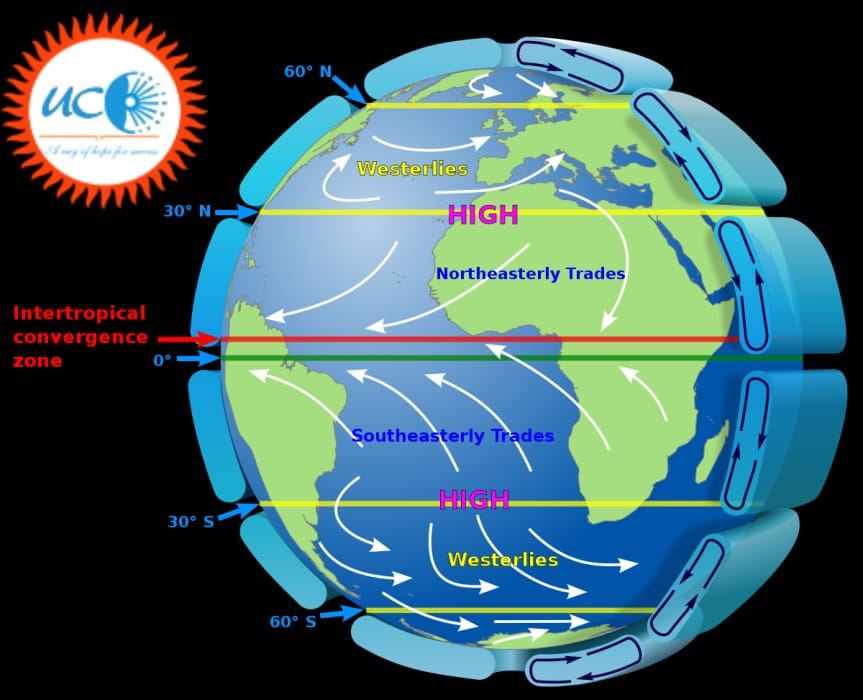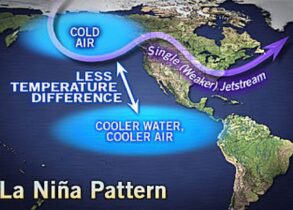What is the mechanism of tricellular meridional circulation of the atmosphere? Discuss its significance
Answer: Earth and its atmosphere are both controlled primarily by the Sun and they make up an interconnected global system. Different climatic areas are the result of atmospheric movements within this global system. Atmospheric circulation is the large-scale movement of air and together with ocean circulation is the means by which thermal energy is redistributed on the surface of the Earth.
The Tricellular meridional circulation of the atmosphere is a simplified explanation of how atmospheric circulation patterns give rise to distinct weather and climatic conditions at various latitudes. It is based upon the premise of differential heating of the Earth’s surface. The basic elements of this theory include:
Mechanisms of Tricellular meridional circulation:
- Hadley cell: The cell is located between 10-30 degree latitudes in both hemispheres. This is a thermally induced cell and is the result of intense solar insolation. The intense insolation produces rising air along the equator.
- The rising air cools down below the tropopause and diverges towards the pole as the anti-trade wind. They lead to upper air around 30 degrees latitude and sink causing the subtropical high pressure.
- The trade wind flows from this High Pressure toward the equator and completes this cell.
- Ferrell Cell: This cell extends from 35 to 60-degree latitude in both hemispheres. This is a thermally indirect cell and induced due to dynamic forces.
- In this cell, the warm air is seen ascending from the polar front and breaking through near the tropopause.
- The most important feature of this cell is that the polar front is more continuous in the middle troposphere. There is a subsidence of air in the horse latitude from the tropical as well as polar front dells.
- On the surface, the circulation is completed by the westerly wind blowing toward the poleward side.
- Polar cell: It extends from 65 10 90 degrees in both hemispheres. This is a thermally direct cell and is strongest during winter.
- There is sinking air along the poles which moves towards the subpolar low as the easterly wind.
- In the subpolar lows, the easterly and westerly interact and the air rises to complete the polar cell circulation.
Significance of tricellular meridional circulation:
- Maintains heat balance: This circulation is fundamental in maintaining latitudinal heat balance of earth.
- Formation of jet streams is the result of these circulation, and upper atmosphere dynamics of rotating earth.
- Formation of doldrums and ITCZ: It aids the formation of doldrums or the inter-tropical Convergence Zone (ITCZ)-the most important and uninterrupted belt of convergence on the surface of the earth.
- Formation of cyclones: The development of tropical cyclones, temperate cyclones, and anticyclones is also the result of meridional circulation.
- Formation of desert: Subtropical highs are responsible for creating aridity, and sustaining off shore winds and trade wind deserts. The interaction of easterly and westerly creates frontogenesis which influences the climate of the subpolar area.
- Precipitation: Convective currents of Hadley cells are responsible for heavy precipitation along equator regions.
The mechanism of general circulation of the atmosphere, thus, includes both, the horizontal
and vertical components of atmospheric circulation. The Hadley, Ferrel and polar cells operate at the largest scale of thousands of kilometers (synoptic scale) creating a variety of atmospheric phenomena affecting the entire life on the planet.







